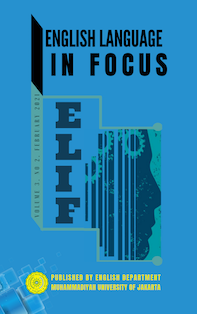Analysis of Teachers-Constructed Reading Comprehension Test
DOI:
https://doi.org/10.24853/elif.3.2.89-98Keywords:
Reading comprehension, HOTS, LOTSAbstract
Constructing tests as part of assessments is the teacher's part in the teaching and learning process. Assessments have a role to evaluate student's comprehension and measure the extent of studying stages' success. Despite its significant value, teachers frequently construct tests without considering the main purpose of the test. This research concerns the way teachers construct their tests. To narrow the research scope, this research focuses on the reading comprehension test since reading comprehension is one of the main language skills for predicting learners' academic and professional development skills. The purpose of this study is to reveal the teacher stages in the construction of a reading comprehension test and the appropriateness of the test according to the test eligibility. To answer research questions, we adopt the qualitative research method. To collect data, we interview English language teachers from different schools who are teaching at different grades from Junior High Schools. Documentation is also be given since the teachers will need some of their final constructed test forms. To analyze the data, researchers calculate the number of HOTS and LOTS questions in the test, as the test eligibility standard. The study found that they are required to create their test indicators based on official general school/regulation indicators. It is also found that even though teachers are not obliged to provide dominant HOTS test items, HOTS test items are frequently discovered.References
Ahmad, U. L. (2016). Senior High School English National Examination and Thinking Skills. Beyond Words, 4(2), 168–190. https://doi.org/10.33508/bw.v4i2.945
Anderson, L. W., Krathwohl, D. R., & Bloom, B. S. (2001). A Taxonomy for Learning, Teaching, and Assessing : A Revision of Bloom’s Taxonomy of Education. New York: Longman.
Assaly, I. R., & Smadi, O. M. (2015). Using Bloom’s Taxonomy to Evaluate the Cognitive Levels of Master Class Textbook’s Questions. English Language Teaching, 8(5), 100–110. https://doi.org/10.5539/elt.v8n5p100
Brown, H. D., & Abeywickrama, P. (2003). Language Assessment: Principles and Classroom Practices. New York: Longman.
Damanik, S. N. H., & Zainil, Y. (2019). The Analysis of Reading Comprehension Questions in English Textbook by Using High Order Thinking Skill at Grade X of SMAN 2 Padang. Journal of English Language Teaching, 8(1), 249–258.
Febrina, Usman, B., & Muslem, A. (2019). Analysis of Reading Comprehension Questions by Using Revised Bloom’s Taxonomy on Higher Order Thinking Skill (HOTS). English Education Journal, 10(1), 1–15. http://jurnal.unsyiah.ac.id/EEJ/article/view/13253
Febriyani, R. A., Yunita, W., & Damayanti, I. (2020). An Analysis on Higher Order Thinking Skill (HOTS) in Compulsory English Textbook for the Twelfth Grade of Indonesian Senior High Schools. Journal of English Education and Teaching, 4(2), 170–183. https://doi.org/10.33369/jeet.4.2.170-183
Hanafi. (2016). Developing Reading Comprehension Test for The First Semester Students of English Department. ELLITE: Journal of English Language, Literature, and Teaching, 1(1), 59–74. https://doi.org/10.32528/ellite.v1i1.164
Hayikaleng, N, Nair, S. M., & Krishnasamy, H. N. (2016). Thai Students’ L2 Reading Comprehension Level for Lower Order Thinking Skills and Higher Order Thinking Skills Questions. Journal of Applied Linguistics and Language Research, 3(5), 83–91. http://www.jallr.com/
Hayikaleng, N, Nair, S. M., & Krishnasamy, H. N. (2016). Using Youtube to Improve EFL Reading Comprehension Among Vocational Student. International Seminar on Generating Knowledge Through Research, 391–398. https://doi.org/10.21070/picecrs.v1i1.507
Izzah, L., & Hadi, M. S. (2018). Systemic Functional Genre on Students’ Reading Literacy. English Language in Focus (ELIF), 1(1), 35-44. https://doi.org/10.24853/elif.1.1.35-44
Jauhari, H. (2013). Terampil Mengarang. Nuansa Cendekia.
Lems, K., Miller, L. D., & Soro, T. M. (2010). Teaching Reading to English Language Learners: Insights from Linguistics. New York: Guilford Press.
McDonough, J., Shaw, C., & Masuhara, H. (2012). Materials and Methods in ELT: A Teacher’s Guide. Wiley-Blackwell.
Narwianta, N., Anggani, D., Bharati, L., & Rukmini, D. (2019). The Evaluation of Higher Order Thinking Skills in English School Nationally Standardized Examination at State Senior High School 6 Semarang. English Education Journal, 9(3), 316–326. https://doi.org/10.15294/EEJ.V9I3.30937
Nofrion, N., & Wijayanto, B. (2018). Learning Activities in Higher Order Thinking Skill (HOTS) Oriented Learning Context. Geosfera Indonesia, 3(2), 122–130. https://doi.org/10.19184/geosi.v3i2.8126
Rose, S., Spinks, N., & Canhoto, A. I. (2014). Management Research: Applying the Principles. Routledge.
Sagala, P. N., & Andriani, A. (2019). Development of Higher-Order Thinking Skills (HOTS) Questions of Probability Theory Subject Based on Bloom’s Taxonomy. Journal of Physics: Conference Series, 1188(1), 12025. https://doi.org/10.1088/1742-6596/1188/1/012025
Tarigan, H. G. (2015). Membaca Sebagai Suatu Keterampilan Berbahasa. Angkasa Bandung.
Downloads
Published
Issue
Section
License
Authors who publish with this journal agree to the following terms:
- Authors retain copyright and grant the journal right of first publication with the work simultaneously licensed under a Creative Commons Attribution License that allows others to share the work with an acknowledgment of the work's authorship and initial publication in this journal.
- Authors can enter into separate, additional contractual arrangements for the non-exclusive distribution of the journal's published version of the work (e.g., post it to an institutional repository or publish it in a book), with an acknowledgment of its initial publication in this journal.
- Authors are permitted and encouraged to post their work online (e.g., in institutional repositories or on their website) before and during the submission process, as it can lead to productive exchanges, as well as earlier and greater citation of published work (See The Effect of Open Access).


